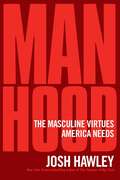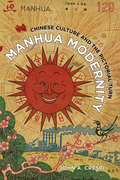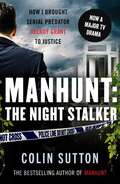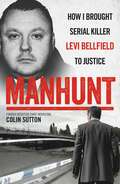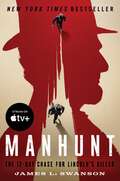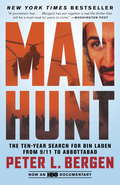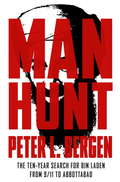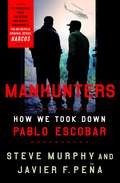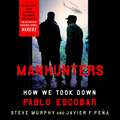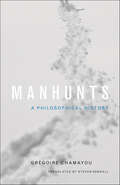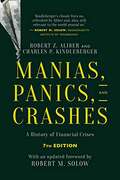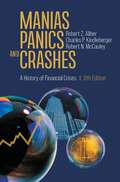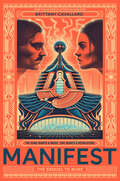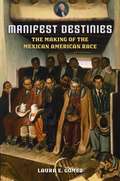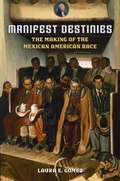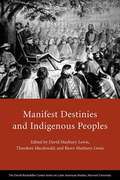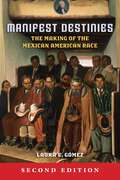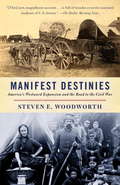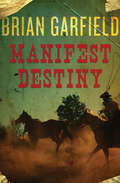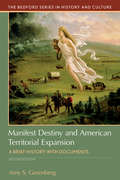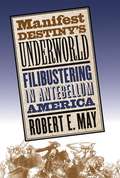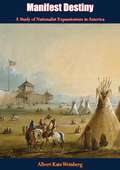- Table View
- List View
Manhood: The Masculine Virtues America Needs
by Josh HawleyNationally best-selling author (The Tyranny of Big Tech), constitutional lawyer, and U.S. senator for the state of Missouri argues that the character of men and the male virtue that goes along with it is a necessary ingredient to a functioning society and a healthy, free republic.A free society that despises manhood will not remain free. The American Founders believed that a republic depends on certain masculine virtues. Senator Josh Hawley thinks they were right. In a bold new book, he calls on American men to stand up and embrace their God-given responsibility as husbands, fathers, and citizens. No republic has ever survived without men of character to defend what is just and true. Starting with the wisdom of the ancients, from the Greek and Roman philosophers to Jesus of Nazareth, and drawing on the lessons of American history, Hawley identifies the defining strengths of men, including responsibility, bravery, fidelity, and leadership. As Theodore Roosevelt declared, the &“very existence of the state depends on the character of its citizens…. I am for business. But I am for manhood first.&” Hawley shows why the foolhardy assault on masculinity in education, the media, the workplace, and every level of government is an assault on freedom itself. Practical, down to earth, and urgent, Manhood: The Masculine Virtues America Needs is required reading for every American patriot.
Manhua Modernity: Chinese Culture and the Pictorial Turn
by John A. CrespiA free open access ebook is available upon publication. Learn more at www.luminosoa.org. From fashion sketches of smartly dressed Shanghai dandies in the 1920s, to multipanel drawings of refugee urbanites during the war against Japan, to panoramic pictures of anti-American propaganda rallies in the early 1950s, the polymorphic cartoon-style art known as manhua helped define China's modern experience. Manhua Modernity offers a richly illustrated, deeply contextualized analysis of these illustrations across the lively pages of popular pictorial magazines that entertained, informed, and mobilized a nation through a half century of political and cultural transformation. In this compelling media history, John Crespi argues that manhua must be understood in the context of the pictorial magazines that hosted them, and in turn these magazines must be seen as important mediators of the modern urban experience. Even as times changed—from interwar-era consumerism to war-time mobilization to Mao-style propaganda—the art form adapted to stay on the cutting edge of both politics and style.
Manhunt, Night Stalker: How I Brought Serial Predator Delroy Grant to Justice (Manhunt #2)
by Colin SuttonWhat does it take to catch a predator who has terrorised south-east England for over fifteen years? Delroy Grant—dubbed the Night Stalker—was one of London's most feared and shocking sex predators. During his reign of terror, he established a clear MO. Visit a target at night. Remove a window pane and slide in. Unscrew the lightbulbs. Cut the power. Rip out the telephone wires. Tiptoe to the bedroom. Wake the victim by shining a torch in their eyes. What followed was often unspeakable. When SIO Colin Sutton was drafted into the case, Grant had been at large for seventeen years. Stepping up where others had failed, he began the determined, relentless police work that had marked the end for infamous serial killer Levi Bellfield. Case by case, clue by clue. Night Stalker is the chilling true story of one of the most testing manhunts the Metropolitan Police have ever undertaken. It is a glimpse into the heart of darkness—and into the mind and work of the brilliant detective who brought one of London's most feared monsters to justice.
Manhunt: How I Brought Serial Killer Levi Bellfield to Justice (Manhunt #1)
by Colin SuttonWHAT DOES IT TAKE TO CATCH ONE OF BRITAIN'S MOST FEARED KILLERS? Levi Bellfield is one of the most notorious British serial killers of the last fifty years—his name alone evokes fear after his brutal murders of Milly Dowler, Marsha McDonnell and Amelie Delagrange. At 3:07pm on 21st March, 2002, Milly Dowler left her school in Surrey for the last time. An hour later, she was to be abducted and murdered in the cruellest fashion. It would be months before her body was found. In the two years that followed, two more young women—Marsha McDonnell and then Amelie Delagrange—were killed in unspeakably brutal attacks. Yet with three dead women on their hands, and few leads, police were running out of ideas—until Senior Investigating Officer Colin Sutton was drafted into the investigation. Seeing a connection between the three women, and thriving under the pressure of a serial killer hunt, Sutton was finally able to bring their murderer to justice. This is the story of how Sutton led the charge, against the clock and against the odds—day by day and lead by lead. At once a gripping police procedural, and an insight into the life of an evil man, Manhunt reveals what it takes to track down a violent serial killer before he strikes again.
Manhunt: The 12-Day Chase for Lincoln's Killer: An Edgar Award Winner
by James L. SwansonSoon to be an Apple TV+ Series“A terrific narrative of the hunt for Lincoln’s killers that will mesmerize the reader from start to finish.”—Doris Kearns GoodwinThe murder of Abraham Lincoln set off the greatest manhunt in American history--the pursuit and capture of John Wilkes Booth. From April 14 to April 26, 1865, the assassin led Union cavalry troops on a wild, 12-day chase from the streets of Washington, D.C., across the swamps of Maryland, and into the forests of Virginia, while the nation, still reeling from the just-ended Civil War, watched in horror and sadness.Based on rare archival materials, obscure trial transcripts, and Lincoln’s own blood relics Manhunt is a fully documented, fascinating tale of murder, intrigue, and betrayal. A gripping hour-by-hour account told through the eyes of the hunted and the hunters, it is history as it’s never been read before.
Manhunt: The Ten-Year Search for Bin Laden from 9/11 to Abbottabad
by Peter L. BergenThe gripping account of the decade-long hunt for the world's most wanted man.It was only a week before 9/11 that Peter Bergen turned in the manuscript of Holy War, Inc., the story of Osama bin Laden--whom Bergen had once interviewed in a mud hut in Afghanistan--and his declaration of war on America. The book became a New York Times bestseller and the essential portrait of the most formidable terrorist enterprise of our time. Now, in Manhunt, Bergen picks up the thread with this taut yet panoramic account of the pursuit and killing of bin Laden. Here are riveting new details of bin Laden's flight after the crushing defeat of the Taliban to Tora Bora, where American forces came startlingly close to capturing him, and of the fugitive leader's attempts to find a secure hiding place. As the only journalist to gain access to bin Laden's Abbottabad compound before the Pakistani government demolished it, Bergen paints a vivid picture of bin Laden's grim, Spartan life in hiding and his struggle to maintain control of al-Qaeda even as American drones systematically picked off his key lieutenants. Half a world away, CIA analysts haunted by the intelligence failures that led to 9/11 and the WMD fiasco pored over the tiniest of clues before homing in on the man they called "the Kuwaiti"--who led them to a peculiar building with twelve-foot-high walls and security cameras less than a mile from a Pakistani military academy. This was the courier who would unwittingly steer them to bin Laden, now a prisoner of his own making but still plotting to devastate the United States. Bergen takes us inside the Situation Room, where President Obama considers the COAs (courses of action) presented by his war council and receives conflicting advice from his top advisors before deciding to risk the raid that would change history--and then inside the Joint Special Operations Command, whose "secret warriors," the SEALs, would execute Operation Neptune Spear. From the moment two Black Hawks take off from Afghanistan until bin Laden utters his last words, Manhunt reads like a thriller.Based on exhaustive research and unprecedented access to White House officials, CIA analysts, Pakistani intelligence, and the military, this is the definitive account of ten years in pursuit of bin Laden and of the twilight of al-Qaeda.
Manhunt: The Ten-year Search for Bin Laden -- from 9/11 to Abbottabad
by Peter L. BergenFrom the author of the New York Times bestselling Holy War, Inc., this is the definitive account of the decade-long manhunt for the world's most wanted man, Osama bin Laden. Al Qaeda expert and CNN national security analyst Peter Bergen paints a multidimensional picture of the hunt for Osama bin Laden over the past decade, including the operation that killed him. Other key elements of the book will include: - A careful account of Obama's decision-making process as the raid was planned - The fascinating story of a group of women CIA analysts who never gave up assembling the tiniest clues about bin Laden's whereabouts - The untold and action-packed history of the Joint Special Operations Command (JSOC) and the SEALs - An analysis of what the death of bin Laden means for Al Qaeda and for Obama's legacy Just as Hugh Trevor-Roper's The Last Days of Hitler was the definitive account of the death of the Nazi dictator, Manhunt is the authoritative, immersive account of the death of the man who organized the largest mass murder in American history.
Manhunters: How We Took Down Pablo Escobar
by Stephen E. Murphy Javier F. PeñaThe explosive memoir of legendary DEA agents and the subject of the hit Netflix series Narcos, Steve Murphy and Javier F. PeñaIn the decades they spent at the DEA, Javier Peña and Steve Murphy risked their lives hunting large and small drug traffickers. But their biggest challenge was the hunt for Pablo Escobar in Colombia. The partners, who began their careers as small-town cops, have been immortalised in Netflix's Narcos, a fictional account of their hunt for Escobar. Now, for the first time ever, they tell the real story of how they brought down the world's first narco-terrorist, the challenges they faced, and the innovative strategies they employed to successfully end the reign of terror of the world's most wanted criminal.Readers will go deep inside the inner workings of the Search Bloc, the joint Colombian-US task force that resulted in an intensive 18-month operation that tracked Escobar. Between July 1992 and December 1993, Steve and Javier lived on the edge, setting up camp in Medellin at the Carlos Holguin Military Academy. There, they lived and worked with the Colombian authorities, hunting down a man who was thought by many to be untouchable. Their firsthand experience coupled with stories from the DEA's recently de-classified files on the search for Escobar forms the beating heart of Manhunters, an epic account of how agents risked everything to capture the world's most wanted man.
Manhunters: How We Took Down Pablo Escobar
by Stephen E. Murphy Javier F. PeñaThe explosive memoir of legendary DEA agents and the subject of the hit Netflix series Narcos, Steve Murphy and Javier F. PeñaIn the decades they spent at the DEA, Javier Peña and Steve Murphy risked their lives hunting large and small drug traffickers. But their biggest challenge was the hunt for Pablo Escobar in Colombia. The partners, who began their careers as small-town cops, have been immortalised in Netflix's Narcos, a fictional account of their hunt for Escobar. Now, for the first time ever, they tell the real story of how they brought down the world's first narco-terrorist, the challenges they faced, and the innovative strategies they employed to successfully end the reign of terror of the world's most wanted criminal.Readers will go deep inside the inner workings of the Search Bloc, the joint Colombian-US task force that resulted in an intensive 18-month operation that tracked Escobar. Between July 1992 and December 1993, Steve and Javier lived on the edge, setting up camp in Medellin at the Carlos Holguin Military Academy. There, they lived and worked with the Colombian authorities, hunting down a man who was thought by many to be untouchable. Their firsthand experience coupled with stories from the DEA's recently de-classified files on the search for Escobar forms the beating heart of Manhunters, an epic account of how agents risked everything to capture the world's most wanted man.(P) 2019 Headline Publishing Group Ltd
Manhunts: A Philosophical History
by Grégoire ChamayouA comprehensive history of manhunting in the West, from ancient times to the presentTouching on issues of power, authority, and domination, Manhunts takes an in-depth look at the hunting of humans in the West, from ancient Sparta, through the Middle Ages, to the modern practices of chasing undocumented migrants. Incorporating historical events and philosophical reflection, Grégoire Chamayou examines the systematic and organized search for individuals and small groups on the run because they have defied authority, committed crimes, seemed dangerous simply for existing, or been categorized as subhuman or dispensable.Chamayou begins in ancient Greece, where young Spartans hunted and killed Helots (Sparta's serfs) as an initiation rite, and where Aristotle and other philosophers helped to justify raids to capture and enslave foreigners by creating the concept of natural slaves. He discusses the hunt for heretics in the Middle Ages; New World natives in the early modern period; vagrants, Jews, criminals, and runaway slaves in other eras; and illegal immigrants today. Exploring evolving ideas about the human and the subhuman, what we owe to enemies and people on the margins of society, and the supposed legitimacy of domination, Chamayou shows that the hunting of humans should not be treated ahistorically, and that manhunting has varied as widely in its justifications and aims as in its practices. He investigates the psychology of manhunting, noting that many people, from bounty hunters to Balzac, have written about the thrill of hunting when the prey is equally intelligent and cunning.An unconventional history on an unconventional subject, Manhunts is an in-depth consideration of the dynamics of an age-old form of violence.
Mani/Pedi: A True-Life Rags to Riches Story
by Krista Beth DriverShe left everything behind and risked not only her life, but also the lives of her two small children to escape from Vietnam after the Fall of Saigon. In the middle of the night, Charlie—along with her husband, two toddlers and two young sisters—joined 100 other people on a tiny boat and fled their home country. The journey was long and dangerous, but after almost two years in refugee camps, the family finally made it to America. After emigrating, as many Vietnamese refugee women did, Charlie began working in the booming nail industry. When her path crossed with Olivett, an African American woman, they became business partners—and built an empire together. After only a few years in the US, Charlie was a millionaire and living the American dream. Her tale is one of tragedy and triumph—a true rags to riches story that will amaze and inspire readers from all walks of life.
Mania: A Short History of Bipolar Disorder (Johns Hopkins Biographies of Disease)
by David HealyThis provocative history of bipolar disorder illuminates how perceptions of illness, if not the illnesses themselves, are mutable over time. Beginning with the origins of the concept of mania—and the term maniac—in ancient Greek and Roman civilizations, renowned psychiatrist David Healy examines how concepts of mental afflictions evolved as scientific breakthroughs established connections between brain function and mental illness. Healy recounts the changing definitions of mania through the centuries, explores the effects of new terminology and growing public awareness of the disease on culture and society, and examines the rise of psychotropic treatments and pharmacological marketing over the past four decades. Along the way, Healy clears much of the confusion surrounding bipolar disorder even as he raises crucial questions about how, why, and by whom the disease is diagnosed. Drawing heavily on primary sources and supplemented with interviews and insight gained over Healy's long career, this lucid and engaging overview of mania sheds new light on one of humankind's most vexing ailments.
Manias, Panics, And Crashes: A History Of Financial Crises
by Robert Z. Aliber Charles P. KindlebergerThis seventh edition of an investment classic has been thoroughly revised and expanded following the latest crises to hit international markets. Renowned economist Robert Z. Aliber introduces the concept that global financial crises in recent years are not independent events, but symptomatic of an inherent instability in the international system.
Manias, Panics, and Crashes: A History of Financial Crises
by Robert Z. Aliber Charles P. Kindleberger Robert N. McCauleyIn the Eighth Edition of this classic text on the financial history of bubbles and crashes, Robert McCauley joins with Robert Aliber in building on Charles Kindleberger's renowned work. McCauley draws on his central banking experience to introduce new chapters on cryptocurrency and the United States as the 21st Century global lender of last resort. He also updates the book's coverage of the recent property bubble in China, as well as providing new perspectives on the US housing bubble of 2003-2006, and the Japanese bubble of the late 1980s. And he gives new attention to the social psychology that leads people to take the risk of investing in Ponzi schemes and asset price bubbles. For the first time in this revised and updated edition, figures highlight key points to ensure that today’s generation of finance and economic researchers, students, practitioners and policy-makers—as well as investors looking to avoid crashes—have access to this panoramic history of financial crisis.
Manic Pixie Dream Earl (Earls Trip)
by Jenny HolidayTed Lasso meets Bridgerton for a 19th century spin on The Hangover in USA Today bestselling author Jenny Holiday&’s laugh-out-loud bromantic comedy featuring three Regency-era Earls on their annual trip—ride-or-die buddies offering one another unconditional support in everything from Lady problems to family woes—especially when this trip is crashed by one earl&’s pen pal. The complicated fallout from his alter ego being exposed may just be the most challenging problem the boys have to solve yet! From the author of CANADIAN BOYFRIEND, the perfect romp for fans of Evie Dunmore, India Holton, Virginia Heath, Manda Collins, and Suzanne Allain!An annual earls&’ trip should provide an escape from a gentleman&’s cares, but in this refreshingly modern Regency-era series, three handsome BFFs find that wherever they go, romantic complications follow . . . When not writing, poet Edward Astley, Viscount Featherfinch, spends his time fending off the young ladies of the ton—and some of its young men—and avoiding his cruel father. As heir to the earldom, Edward knows he must marry someday. Alas, he is already hopelessly in love with someone. Hopeless because not only is Miss Julianna Evans not a member of the aristocracy, she is employed. She is a magazine editor—the only one to publish his work. Also, in all their years of increasingly personal correspondence, they&’ve never met. Also, she thinks he&’s a woman. Named Euphemia. Julianna is baffled. How can her soul mate not want to meet? Could it be that Euphemia is not the simple country girl she claims to be? Perhaps she&’s wealthy. After all, she&’s never cashed any of the bank drafts Julianna has sent. Perhaps Euphemia simply doesn&’t want rank to come between them. Well, no more. Having extracted the details of a trip Euphemia is planning, Julianna squanders her meager savings and surprises her at the scene. He is very, very surprised. As is she. Now the two will have to decide what is true, what is not, and whether the truest thing of all—love—just might be worth an earldom . . .
Manifest
by Brittany CavallaroNew York Times bestselling author Brittany Cavallaro delivers the thrilling conclusion to her YA duology set in a reimagined American monarchy about a girl fighting for her own freedom, trying to change the government from within . . . or burn it all down.For the first time in her life, Claire Emerson isn’t under a man’s control. She’s escaped from her dangerous father, and her fiancé, Governor Remy Duchamp, is too weak to rule. All eyes fall on Claire—and the power she could wield.But that power is precarious as she and Remy are leading St. Cloud in exile after the General’s attempted coup. And when King Washington descends on the small province, he brings with him his baseball team, Claire’s brother, and a proximity to power Claire has never dreamed of. With few allies to support her, she determines her best chance at survival is earning the King’s good graces. Claire’s schemes quickly get out of hand, reminding her that it isn’t about who holds the power. It’s about a system that grants such power to a select few, and the men who built it that way. Claire isn’t anyone’s muse, and if she can’t fix the system from within, she’s determined to be the spark of revolution in the First American Kingdom.
Manifest Destinies
by Laura E. GómezUsing the territory that is now New Mexico as a case study, Manifest Destinies traces the origins of Mexican Americans as a racial group in the United States, paying particular attention to shifting meanings of race and law in the nineteenth century.
Manifest Destinies
by Laura E. GómezWatch the Author Interview on KNMEIn both the historic record and the popular imagination, the story of nineteenth-century westward expansion in America has been characterized by notions of annexation rather than colonialism, of opening rather than conquering, and of settling unpopulated lands rather than displacing existing populations. Using the territory that is now New Mexico as a case study, Manifest Destinies traces the origins of Mexican Americans as a racial group in the United States, paying particular attention to shifting meanings of race and law in the nineteenth century.Laura E. Gómez explores the central paradox of Mexican American racial status as entailing the law's designation of Mexican Americans as &#"white" and their simultaneous social position as non-white in American society. She tells a neglected story of conflict, conquest, cooperation, and competition among Mexicans, Indians, and Euro-Americans, the region's three main populations who were the key architects and victims of the laws that dictated what one's race was and how people would be treated by the law according to one's race.Gómez's path breaking work--spanning the disciplines of law, history, and sociology--reveals how the construction of Mexicans as an American racial group proved central to the larger process of restructuring the American racial order from the Mexican War (1846-48) to the early twentieth century. The emphasis on white-over-black relations during this period has obscured the significant role played by the doctrine of Manifest Destiny and the colonization of northern Mexico in the racial subordination of black Americans.
Manifest Destinies and Indigenous Peoples
by David Maybury-Lewis Theodore Macdonald Biorn Maybury-LewisHow was frontier expansion rationalized in the Americas during the late nineteenth century? As new states fleshed out expanded national maps, how did they represent their advances? Were there any distinct pan-American patterns? The renowned anthropologist and human rights advocate David Maybury-Lewis saw the Latin American frontiers as relatively unknown physical spaces as well as unexplored academic territory. He invited eight specialists to explore public narratives of the expansion of Argentina, Brazil, Chile, and the western regions of Canada and the United States during the late nineteenth century, a time when those who then identified as Americans claimed territories in which indigenous peoples, who were now seen as economic and political obstacles, lived. The authors examine the narrative forms that stirred or rationalized expansion, and emphasize their impact on the native residents. The authors illustrate the variety and the similarities of these nationalist ideas and experiences, which were generally expressed in symbolic and cultural terms rather than on simple materialist or essentialist grounds. The cases also point out that civic nationalism, often seem as inclusive and more benign than ethnic nationalism, can produce similarly destructive human and cultural ends. The essays thus suggest a view of nationalism as a theoretical concept, and of frontier expansion as a historical phenomenon.
Manifest Destinies, Second Edition: The Making of the Mexican American Race
by Laura E GómezManifest Destinies is an essential resource for understanding the complex history of Mexican Americans and racial classification in the United States. This is the history of the original Mexican Americans—the people living in northern Mexico in 1846 during the onset of the Mexican American War. The war abruptly came to an end two years later, and 115,000 Mexicans became American citizens overnight. Yet their status as full-fledged Americans was tenuous at best. Due to a variety of legal and political maneuvers, Mexican Americans were largely confined to a second class status. How did this categorization occur, and what are the implications for modern Mexican Americans? Manifest Destinies fills a gap in American racial history by linking westward expansion to slavery and the Civil War. In so doing, law and sociology professor Laura E. Gómez demonstrates how white supremacy structured a racial hierarchy in which Mexican Americans were situated relative to Native Americans and African Americans alike. Steeped in conversations and debates surrounding the social construction of race, this book reveals how certain groups become racialized, and how racial categories can not only change instantly, but also the ways in which they change over time. This second edition is updated to reflect the most recent evidence regarding the ways in which Mexican Americans and other Latinos were racialized in both the twentieth and early twenty-first centuries. The book ultimately concludes that it is problematic to continue to speak in terms of Hispanic &“ethnicity&” rather than consider Latinos qua Latinos alongside the United States&’ other major racial groupings. A must read for anyone concerned with racial injustice and classification today.
Manifest Destinies: America's Westward Expansion and the Road to the Civil War
by Steven E. WoodworthThis sweeping history of the 1840s captures America's enormous sense of possibility and shows how the extraordinary expansion of territories forced the nation to come to grips with the deep rift that would bring war just a decade later.
Manifest Destiny
by Brian GarfieldA rollicking adventure starring a young Theodore RooseveltIn 1884, Teddy Roosevelt&’s political career is dead in the water. A New York state assemblyman with eyes on national office, he finds his ambitions thwarted just months after his wife and infant daughter pass away. Frustrated by politics, he retires to the American West to ride, ranch, and hunt buffalo in the Dakota Badlands. Nobody tells him that the buffalo are gone. He arrives in Dakota a greenhorn, awkward in the saddle and unused to Western clothes. But his aristocratic charm, natural intelligence, and love of nature impress the hardened frontiersmen, forming a bond that lasts the rest of their lives. When a wealthy French marquis threatens the pristine country he has fallen in love with, Roosevelt joins with the Dakotans to defend it. Before the presidency, before San Juan Hill, it was in Dakota that Theodore Roosevelt became a man.
Manifest Destiny and American Territorial Expansion: A Brief History with Documents (A Bedford Series in History and Culture)
by Amy S. GreenbergThe new edition of Amy Greenberg's Manifest Destiny and American Territorial Expansion continues to emphasize the social and cultural roots of Manifest Destiny when exploring the history of U. S. territorial expansion. With a revised introduction and several new documents, this second edition includes new coverage of the global context of Manifest Destiny, the early settlement of Texas, and the critical role of women in America's territorial expansion. Students are introduced to the increasingly influential transnational concept of settler colonialism, while maintaining a central focus on the ideological origins, social and economic impetus, and territorial acquisitions that fueled U. S. territorial expansion in the nineteenth century. Readers of the revised edition will also find an updated bibliography reflecting both the historiography of American expansion and its transnational context, as well as updated questions for consideration.
Manifest Destiny's Underworld
by Robert E. MayThis fascinating study sheds new light on antebellum America's notorious "filibusters--the freebooters and adventurers who organized or participated in armed invasions of nations with whom the United States was formally at peace. Offering the first full-scale analysis of the filibustering movement, Robert May relates the often-tragic stories of illegal expeditions into Cuba, Mexico, Ecuador, Nicaragua, and other Latin American countries and details surprising numbers of aborted plots, as well. May investigates why thousands of men joined filibustering expeditions, how they were financed, and why the U.S. government had little success in curtailing them. Surveying antebellum popular media, he shows how the filibustering phenomenon infiltrated the American psyche in newspapers, theater, music, advertising, and literature. Condemned abroad as pirates, frequently in language strikingly similar to modern American denunciations of foreign terrorists, the filibusters were often celebrated at home as heroes who epitomized the spirit of Manifest Destiny.May concludes by exploring the national consequences of filibustering, arguing that the practice inflicted lasting damage on U.S. relations with foreign countries and contributed to the North-South division over slavery that culminated in the Civil War.Robert May offers an imaginative new approach to antebellum America's notorious "filibusters--the adventurers who organized or participated in private military attacks on nations with which the United States was formally at peace. Condemned abroad as pirates, the filibusters were often celebrated at home as heroes who epitomized the spirit of Manifest Destiny. May explains the romantic, mercenary, ideological, and psychological desires that drove thousands of men to join filibustering expeditions; how they were financed; and why the U.S. government had little success in curtailing them. He also reveals the legacy of anti-Americanism that filibustering generated in Latin America, where people regarded the attackers much the way we look upon international terrorists today.-->
Manifest Destiny: A Study of Nationalist Expansionism in America (History Of The United States Ser.)
by Albert Katz WeinbergA fertile analysis of the ideology of American expansionism and its relation to national action. The history of the moral justifications that have accompanied the development of the United States is an illuminating study of the evolution of American nationalism.“[The author] has painstakingly collected and dissected the arguments employed by American leaders to justify such annexations, beginning with Louisiana and Florida, and ending with the acquisitions growing out of the Spanish War. The object of his quest has been an understanding of the motives which have prompted the territorial growth of the United States.”—New York Times“As a source book in the dicta of democracy it is indispensable.”—New Republic“A clear, dispassionate light on recurring crises in American history. The book should be required reading for imperialists everywhere.”—Christian Science Monitor
